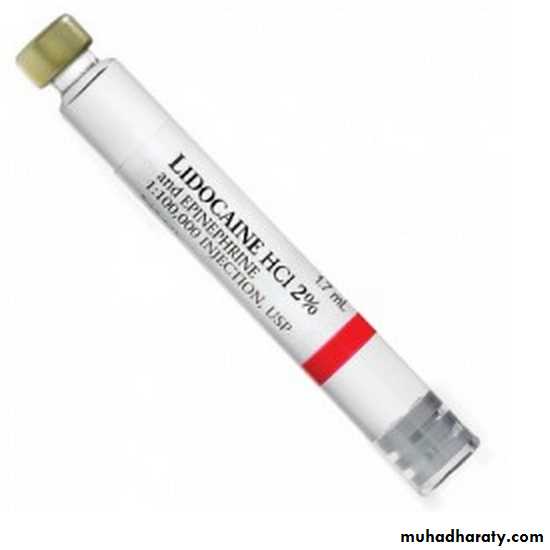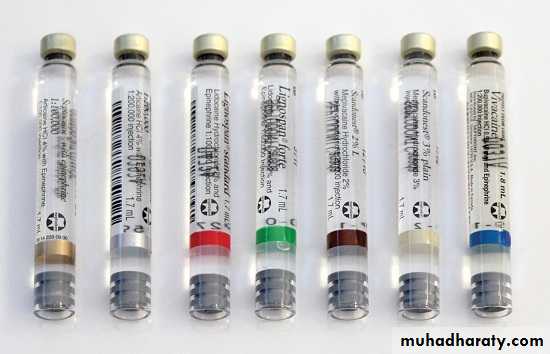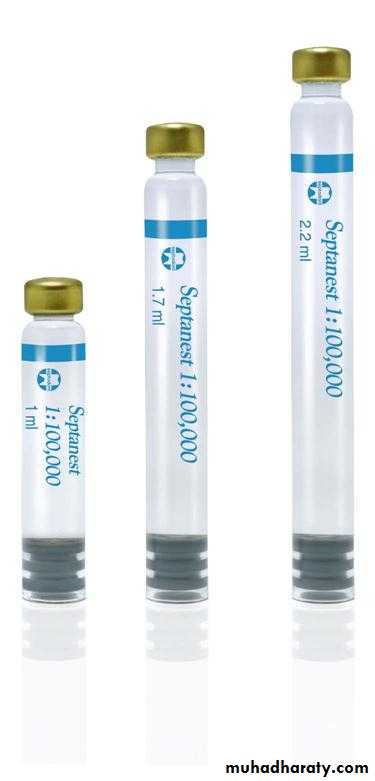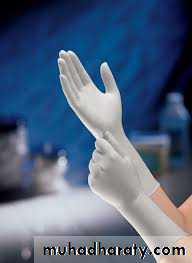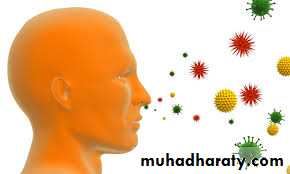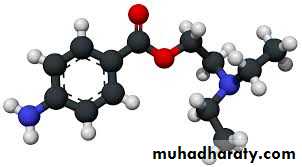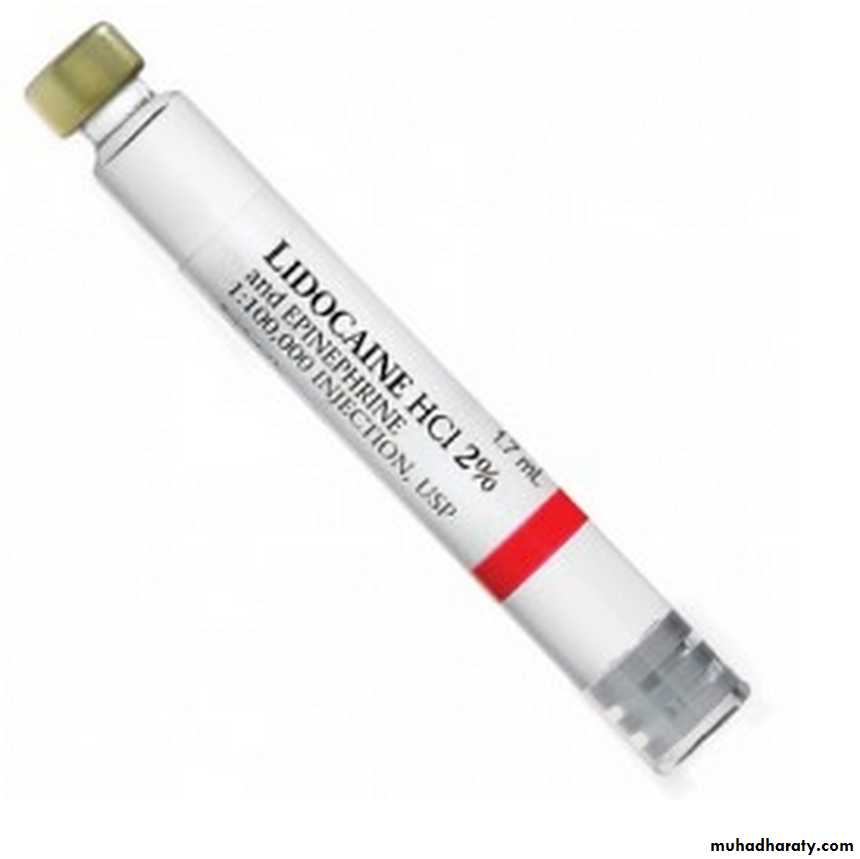Oral Surgery
Local AnesthesiaLocal anesthetic cartridge and vials
It contains primary the Local anesthetic agent and also the other ingredients which are as follows :1. Local anesthetic drug .
2. Vasoconstrictor drug .
3. Preservative for the Vasoconstrictor .
4. Ringers solution .
5. Distilled water .
6. General Preservative .
Local anesthetic drugs (agents)
Local anesthetic are drug which upon topical application or local injection cause reversible loss of sensory perception , especially of pain in a restricted area of the body , it provides pain control during dental therapy , it interrupts propagation of impulse preventing it from reaching the brain.These drug are listed by their percentage (%) concentration , the number of mg of an agent contained in the cartridge can be calculated by multiplying the percentage (%)concentration by the number of ml in the cartridge , thus a cartridge containing 2ml of 2% local anesthetic solution contain 40 mg of local anesthetic agent as
2% = 20 mg/ml by 2 (the number of the cartridge )=
40 mg of local anesthetic agent
Properties of an ideal local anesthetic agent
Despite the constant development of new drugs , the ideal local anesthetic agent has yet to be introduced into clinical practice , however ; it is useful to consider the requirement of the ideal agent when assessing the L.A. should have the following properties :A- Potency and reliability : the first requirement of such a substance is that when administered correctly and in an adequate dosage it consistently produces effective local anesthesia . earlier agent (e.g. cocaine ) were obtained from natural sources and there was considerable variation in their purity , potency , and reliability . these problems have been overcome by present – day methods of production and packaging . thus experience has shown that approximately 98% of injections using a 2% lignocaine with 1:80:000 adrenaline solution are following by effective anesthesia .
B- Reversibility of action : the action of any drugs used to obtain local anesthesia must be completely reversible within a predictable time .
C- Safety : all local anesthetic agent must have a wide margin of safety from the poisonous side-effects which are collectively known as toxicity .
D- Lack of irritation :no injury to or irritation of the tissues should result from the injection of a local anesthetic agent . for this reason local anesthetic solutions should be isotonic and have PH compatible with that of tissues .
Reversibility
Lack of irritation
E- Rapidity of onset : ideally the injection of such an agent should be followed immediately by the onset of local anesthesia , experiments have shown that the mean onset time following infiltration anesthesia using 2% lignocaine with 1:80:000 adrenaline solution is about 1 minute 20 seconds .
F- Duration of effect : in theory recovery of sensation should coincide with the completion of treatment . in practice the duration of anesthesia is usually longer than is required for dental procedures .
G- Sterility : since local anesthetic agent are introduced into the tissues it must be possible to sterilize them without affecting either their structure or properties .
Duration
SterilityRapidity
H- Adequate shelf life : unless the local anesthetic agent is stable in solution and compatible with the other constituents the shelf life of the preparation will be reduced .
I- Penetration of mucous membrane : ideally the drug should have the property of penetrating mucous membrane .
J- free from producing allergy .
K- .
It should be stable in solution and readily undergo biotransformation in the body
penetration
AllergyStable
Properties of an ideal local anesthetic agent:
A- Potency and reliability H- Adequate shelf lifeC- Safety I- Penetration of mucous membrane
B- Reversibility of action J- free from producing allergic
D- Lack of irritation K. stable in solution
E- Rapidity of onset
F- Duration of effect
G- Sterility
Classification of local anesthetics
The local anesthetic agent can be classified in various ways1- On the basis of occurrence in nature
a- Naturally occurrence e.g. cocaine
b- Synthetic compound e.g. procaine , lignocaine , bucricaine .
2- On the basis of duration of action
a- Short – acting as articaine , lidocanie , prilocanie .
b- Long acting as bupivacaine , bucricaine .
3- On the basis of chemical structure
a- Ester .
b- Amide .
Local anesthetics agent classified as either esters or amide according to their chemical linkages , the chemical structure is shown below :
Ester type R
Amide type R
COOR1NHCO
R2
N
N
R2
R3
R4
Lipophilic part
Intermediate chainHydrophilic part
The lipophilic part is the largest portion of the molecule , which is aromatic in structure , while the hydrophilic part is in an amino derivative of ethyl alcohol or acetic acid , the chemical structure is completed by an intermediate hydrocarbon chain containing either an ester or an amide linkage . all local anesthetics possess both lipophilic and hydrophilic characteristics generally at opposite ends of the molecule
The ester type includes the following :
1. Procaine .2. Chloroprocaine .
3. Propoxycaine .
4. Butacaine .
5. Benzocaine .
The amide types include the following :
1. Lidocaine .
2. Prilocaine .
3. Articaine .
4. Bupivacaine .
5. Dibucaine .
6. Etidocaine .
Pharmacokinetic of local anesthesia
Distribution :Once absorbed into the blood local anesthesia are distributed throughout the body to all tissues . the blood level of local anesthetic is influenced by the following factors :
A- Rate at which the drug is absorbed into the cardiovascular system .
B- Rate of distribution of the drug from the vascular compartment to the tissue (more rapid in healthy patients than in those who are medically compromised as congestive heart failure patients )
C- Elimination of the drug through the metabolic or excretory pathways .
Metabolism
a- Ester local anesthetics :
Ester local anesthetics hydrolyzed in plasma by the enzyme pseudo cholinesterase . procaine undergoes hydrolysis to para aminobnzoic acid which is excreted unchanged in the urine
Allergic reactions that occur in response to ester drugs are usually not related to the parent compound as procaine but rather to paraaminobnzoic acid which is a major metabolic product of ester local anesthetics . peoples having a typical form of pseudo cholinesterase get inability to hydrolyze ester local anesthetics and other chemically related drugs thus prolongation of higher blood levels of the local anesthetic and an increased potential for toxicity .
b- Amide local anesthetics
The metabolism of the amide type is more complex and somewhat than that of the ester type , it appears that breakdown does not occur in the blood stream and that hydrolysis take place mainly in the presence of catalysts in the liver , the product are then oxidized further and some conjugation with glu-curonic acid takes place finally conjugated and unconjugated products are excrete in the urine .Excretion
The kidney are the primary organ for both local anesthetics and its metabolites . a percentage of a given dose of local anesthetic drug will be excreted unchanged in the urine and this varies according to the drug . esters appear in only very small concentration as in parent in the urine ; this is because they are hydrolyzed almost completely in the plasma .Amides are usually present in the urine ; this is because they are hydrolyzed almost completely in a greater percentage than the esters , because of their more complex process of biotransformation , patients with significant renal impairment may be unable to eliminate the local anesthetic compound or its metabolites from the blood , resulting in slightly elevated blood levels and an increase potential for toxicity . this may occur with either the esters or amides drugs .
Common local anesthetic agents
Lignocaine (lidocaine , xylocaine )Lignocaine: it is most commonly used local anesthetic agent in dentistry , it is first non – ester type of local anesthetic agent to be used in dentistry , it is stable as it can be stored for a long time at room temperature , it withstand boiling and autoclaving , it is compatible with all types of vasoconstrictor .
Pharmacology and biotransformation
Diffusion : it rapidly diffuses through intestinal tissue , into lipid rich nerve giving a rapidly onset of anesthesia .Biotransformation : lidocaine undergoes biotransformation in the liver .
A – metabolism : lidocaine metabolized in the liver by microsomal fixed – function .oxides .
b- excretion : lidocaine and it is breakdown products are excreted to some extent in urine by kidney .
Potency : 2 times potent as procaine , today it is taken as a standard for comparison of various other local anesthetic agents .
Toxicity : 2 times as toxic as procaine .
Time of onset of action : rapid (2-3 min )
Effective dental concentration : 2%
Anesthetic half-life : 1.6 hours .
Maximum recommended does : the maximum recommended dose for lidocaine with or without a vasoconstrictor is 4.4 mg kg body weight .
Availability in dentistry : dental cartridge of 2% lidocaine with epinephrine 1:80,000 .
Other popular local anesthetics agents as mepivacaine , bupivacaine , and prilocaine .
Selection of local anesthetic agent
There are several anesthetic agents available for use in dentistry , each agent has got its own indications , The agents are selected on the basis of the needs of each patient , the following factors are to be considered for the selection of particular agent1. Duration of action .
2. Need for control of post-operative pain .
3. Physical and mental status of the patient .
4. Concomitant medications .
Duration of action : it is an important aspect , an approximate duration for completing of surgical procedure for which anesthesia is required should be taken into account , the working time should be adequate , on the basis of duration of action local anesthetic agents can be grouped as :
1. Ultra- short acting agents : where the duration of action is less than 30 min as .
a- Procaine without vasoconstrictor .
b- 2% lidocaine without vasoconstrictor .
c- 4% prilocaine without vasoconstrictor .
2- short- acting agents : where the duration of action is 45 to 75 min .
a- 2% lidocaine with vasoconstrictor .
b- 2% mepivacaine with vasoconstrictor.
3-medium – acting agents : where duration of action 90 to 150 min as 4% prilocaine with vasoconstrictor .
4- Long acting agents : where the duration of action 150 min or longer as o.5% of bupivacaine .
Need for control of pain
Most of oral surgical procedures result in varying amount of post operative pain. The local anesthetic agent serves as additional medication that sometimes eliminates the need for postoperative analgesia . The local anesthetic agent that have shown to produce longer duration of analgesia even after the other sensations have returned are bupivacaine and etidocaine .
Physical, Medical and Mental status of the patient
Any co-existing medical condition such as hypertension, diabetes should be considered , a patient with history of allergy to a specific local anesthetic agent , or any other components used along with the local anesthetic agent should be considered . the mental status of the patient has to be evaluated , as small children and mentally retarded patient may traumatize their lip , tongue or check`s due to the effect of local anesthesia , hence for these reasons , the use of long acting local anesthetic agents is contraindicated in such patients .Concomitant medication
The use of vasoconstrictors is contraindicated in patients who are taking Monoamino- oxidase (MAO) inhibitor , tricyclic (TCA) antidepressants .
Thank
Youfor
Listening

